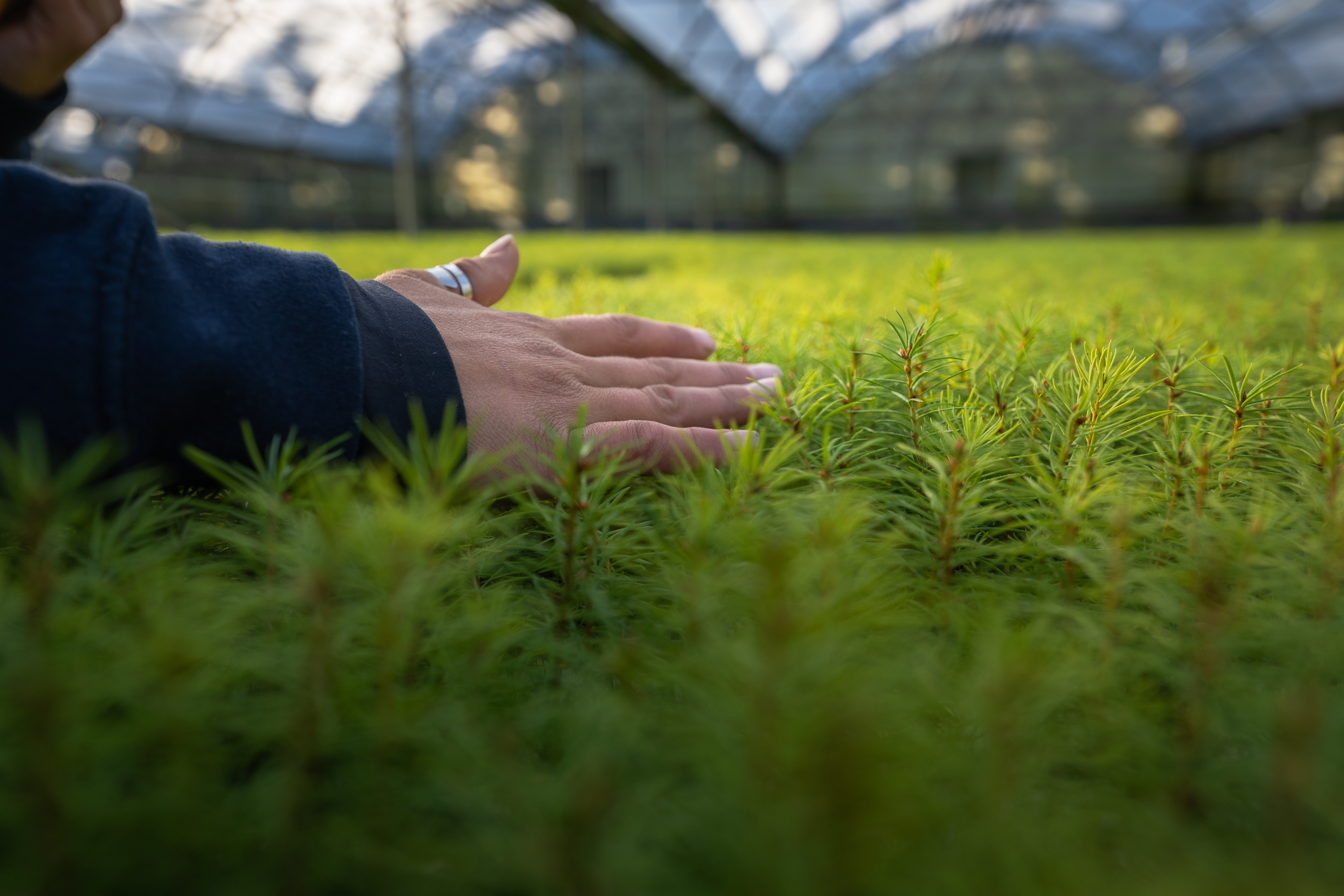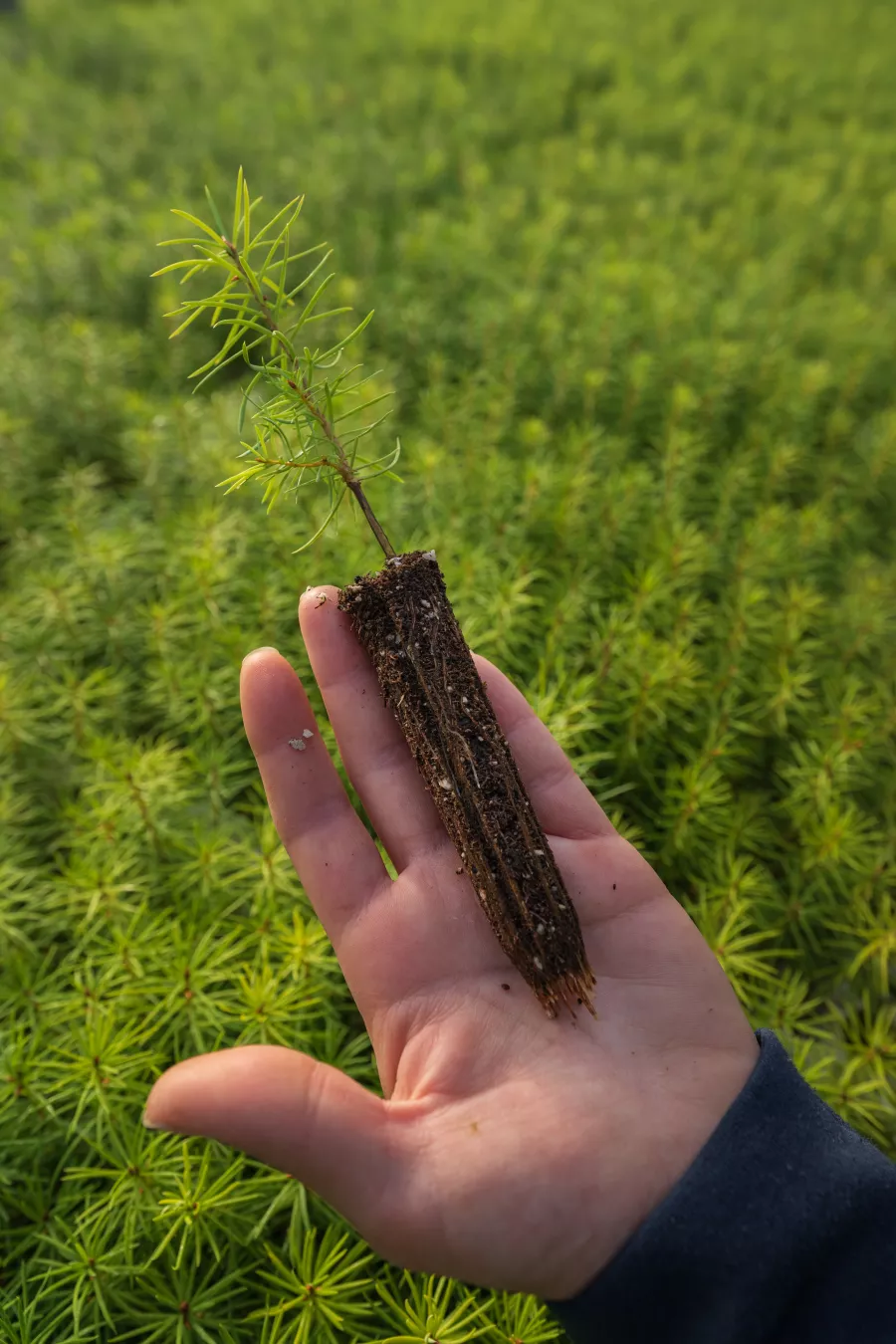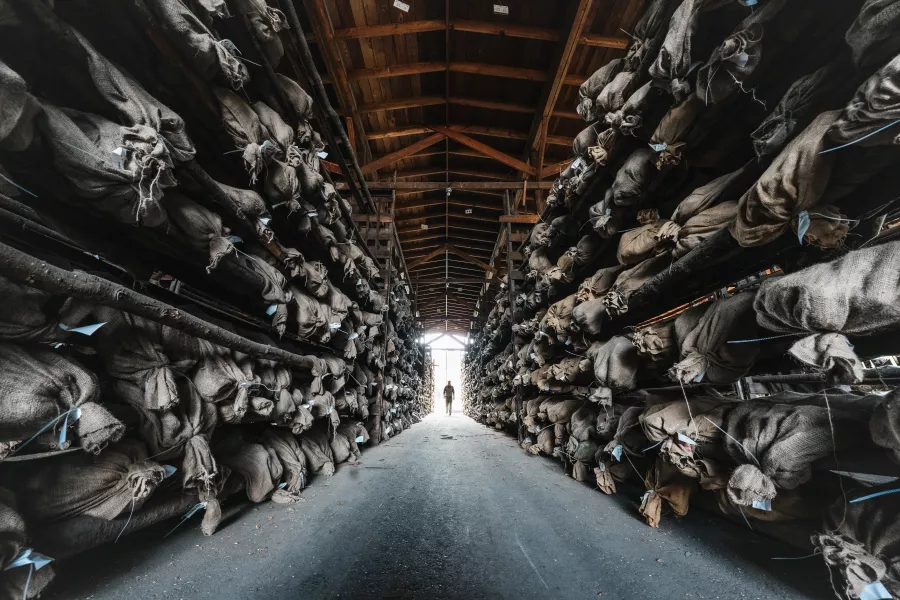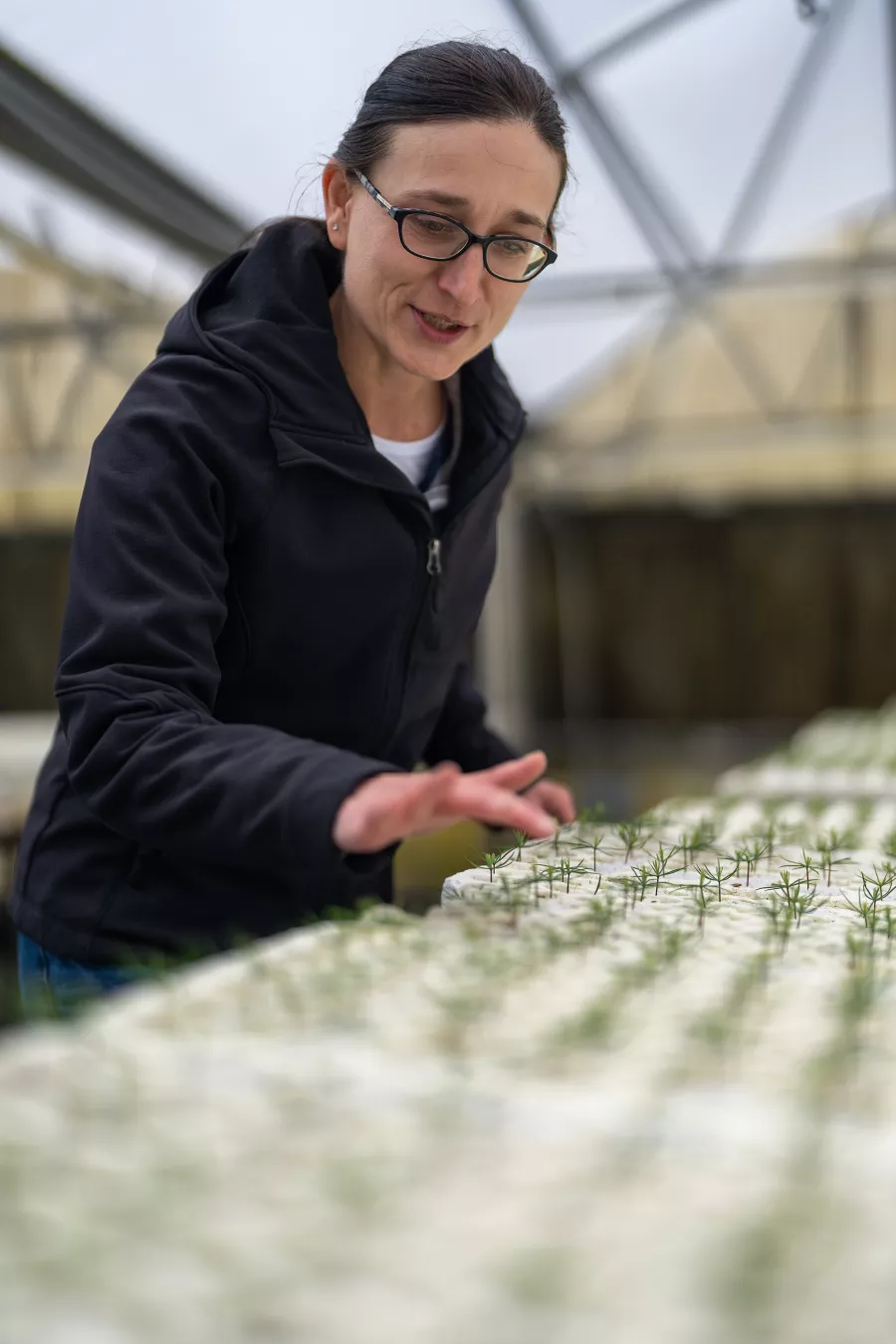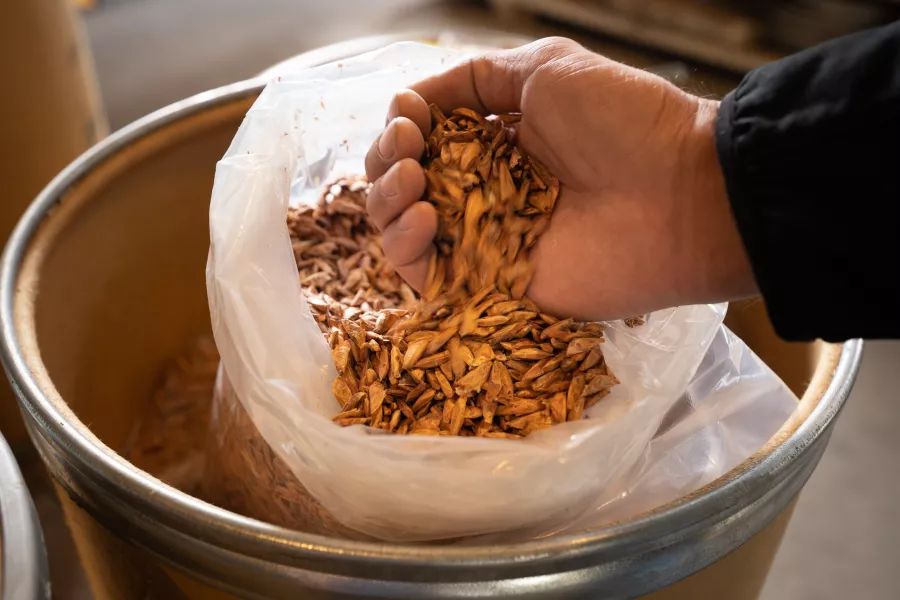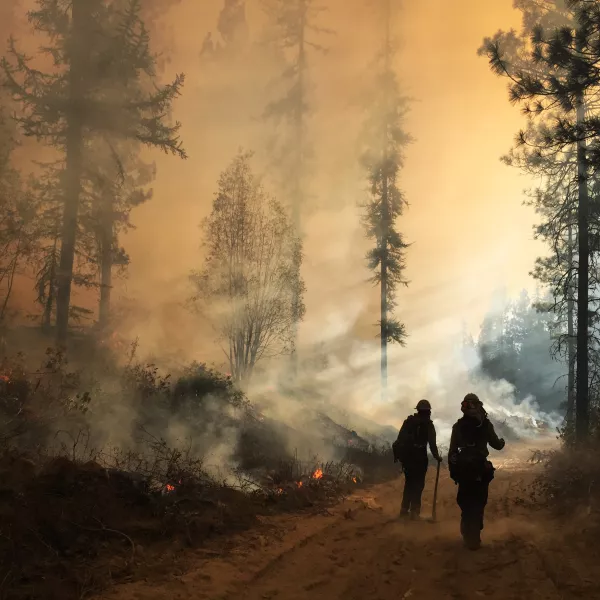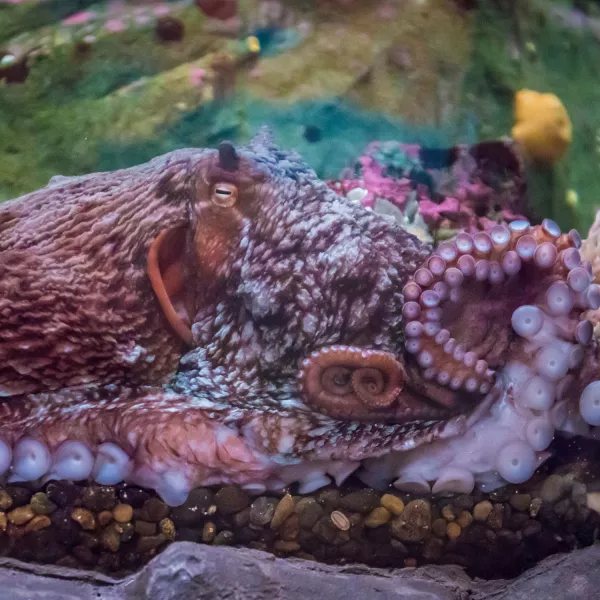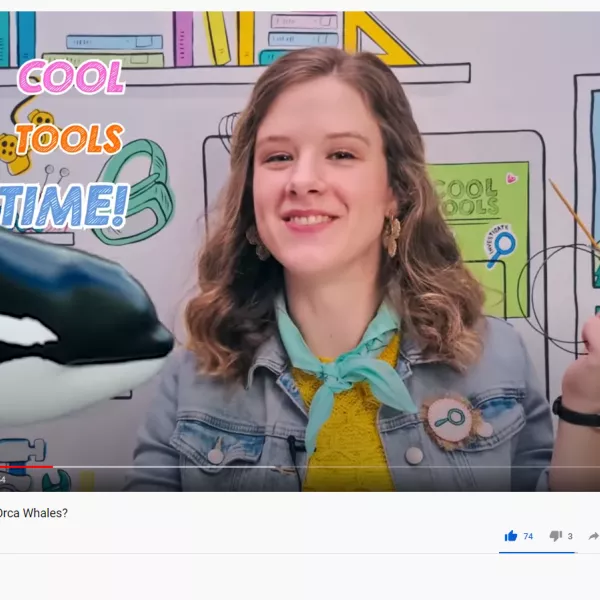Kea Woodruff, ’03, B.A., geography, is ramping up seedling production for the biggest reforestation effort the West has ever seen.
After two summers of heavy fires, foresters have nowhere near enough seedlings available to replant the newly burned-off land. With drought still gripping the West, 2022 may see just as much burning. Throw in federal government money and a policy ambition to plant billions of trees, and you end up with a huge demand for seedlings.
And as senior operations manager for DroneSeed, Woodruff is in the business of growing them. DroneSeed hired her in 2021 when it bought The Silvaseed Company, then Washington’s biggest private producer of seedlings.
Before that, her career took her across the country and the world. After getting a master’s degree in forestry at the University of Idaho, she worked there at the Franklin Pitkin Nursery, managing greenhouses that held a great diversity of trees, including 50 species of conifers. Then she took a job managing the research greenhouses at Harvard University. While that was a wonderful experience, she wanted something more.
“It wasn’t the same impact, in terms of really putting plants back into the landscape, in terms of really helping with this reforestation challenge that is huge, and that we’re all facing right now.”
When she got the call from DroneSeed, she was working as a U.S. Forest Service technical adviser in Liberia, training people and helping expand nursery operations. She said yes. “I was thrilled to get to come back to the Pacific Northwest and address this insane challenge we have: to get 10 times more seedlings out in the ground than we’ve been able to get in the last decade.”
Millions of ‘babies’
Seedlings are the mainstay of any reforestation plan. They are planted in the spring, grow in the greenhouse for the summer, move outside to adapt to cold, and go into cold storage for the winter. Some go to customers the first fall, others the first spring, and the remainder are planted in the ground to grow for another season before being sold as two-year-olds.
In their first year, they’re very simple. A shock of new needles above the soil, and a root beneath them. Woodruff calls them “babies.”
“When people come in for a tour they ask ‘Can I pet the trees? Can I pet them?’ And yeah, people love to walk down the aisles and put their hands over the little baby trees.”
Petting is good for the seedlings. Touch prepares them for the wind and wandering animals that will be part of their lives in the wild.
“It helps them build up nice, thick cambium in their stems,” Woodruff says.
She has nearly 10 million of these babies in her care in the nurseries she supervises. She’ll soon have millions more. DroneSeed is planning to double its capacity for seedlings in the next year and triple it the year after that, while expanding the area it serves, from coastal Washington and Oregon, to take in Idaho, Montana, and California as well.
“It’s shocking to me how fast they’re moving,” Woodruff says.
The trees she grows are destined for public lands and private lots, big land managers, and landowners with 20 acres or so.
There are many challenges to the work.
When last June’s heat dome sent temperatures soaring 20 degrees or more above normal, she ended up pulling 12- to 14-hour days over a weekend at the nursery in Roy, monitoring the fuel of a tractor engine running a well pump keeping the seedlings watered when the temperature rose over 90 degrees. They still ended up losing some.
At least she had water. In Washington and Oregon, the high temperatures were deadly to newly planted seedlings. In some areas, land managers reported most young plants were reduced to sticks in the ground. Which meant they needed still more seedlings.
“They ordered 50,000 or they ordered 100,000 seedlings from us and the heat dome came through and suddenly they needed two or three times that volume.”
Seed hustle
Finding labor is always a worry, and she’s also had to hustle for supplies, such as burlap.
But the biggest supply conundrum she faces is seeds.
For each of her millions of greenhouse babies, Woodruff needs a seed from a forest tree. And not just any tree will do. To have the best chance of thriving, a seedling needs to originate from a seed in the area where it will be eventually planted. A Douglas fir seed from the soggy Olympic Peninsula is not a good fit for the drier Willamette Valley, for example. Also, trees don’t produce seed every year. Douglas firs, for instance, produce hardly any cones most of the time, but every five to seven years, they produce a bumper crop. It’s part of a strategy to stay ahead of squirrels and seed-eating animals; if the tree produces a lot of seeds, the animals won’t be able to eat them all. For some species, these years of plentiful cones, called “mast years,” used to show up in a predictable pattern, but with climate change, that has changed.
“Every year we’re not really sure where we’re going to get seed,” she says.
When it comes to finding seed, there’s only one method that works: have people drive out through remote forests scanning the surrounding areas with binoculars looking for trees with branches bending under the weight of cones.
“We’re always competing with the squirrels,” Woodruff says.
Before it jumped into the nursery business, DroneSeed was best known for pioneering a way to plant trees in places human-tree planters can’t reach, by using heavy-lifting drones to pelt pucks of seeds and nutrients into the ground.
And in that spirit of innovation, Woodruff is looking for tweaks to improve how they grow seedlings. The industry standard since the 1970s has been to plant seeds in “Styroblocks” —literally blocks of plastic foam with individual tube-shaped holes. Her team is experimenting with different containers in hopes of making sturdier seedling roots.
Her team is upgrading the environmental control and datagathering capabilities of greenhouses, and planning the many new greenhouses that DroneSeed is building, with new features such as blackout cloth, which can simulate winter conditions and stops seedlings from growing. (Runaway growth leads to unbalanced seedlings that don’t survive as well in the wild.)
Racing ahead of wildfires
She is also figuring out how to plan what trees she grows in the future. The range of trees throughout the West is shifting because of increased temperatures. For example, western hemlock, the state tree of Washington, is dying in parts of its range because it can’t tolerate higher temperatures. So the best way to restore the forest may be to replace the trees with species that are more heat and drought dependent.
“Trees can’t migrate at the speed that we have changed the climate. And so it’s likely that we are going to have to do some experimentation and some moving things around to give nature help,” she says.
The aim is to have appropriate seedlings ready to go into the ground as soon after a fire as possible.
After a bad fire, there’s a limited time to plant trees. Ash adds some nutrients, but they’ll wash away if you don’t plant in time.
Wait too long and erosion sets in, and other plants take root. Forests can restore themselves after a fire, but it can take decades longer, particularly in places that are far from trees that survived the blaze. And if invasive species, such as Scotch Broom, move in, then a forest might not be able to regenerate at all.
So the aim is to have enough seedlings that whenever there is a fire, planters can put in seedlings within a year. Given that most fires happen in summer and fall, and seedlings are planted in spring, this means that the tree babies have to be already growing in the greenhouse months before the fire starts.
Woodruff doesn’t have to just catch up to wildfires. She has to get ahead of them.
That won’t happen this year. It probably won’t happen next year either.
But it just might happen the year after that.
“That’s the hope.”
